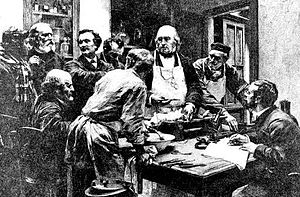- Marie Françoise Bernard
-
Marie Françoise "Fanny" Bernard Born Marie Françoise Martin Nationality French Known for Anti-vivisection campaigner Religion Roman Catholic Spouse Claude Bernard Children Two daughters, Jeanne-Henriette and Marie-Claude, and a son who died in infancy Marie Françoise "Fanny" Bernard (née Martin) was the wife of the French physiologist, Claude Bernard. Claude (1813–1878) is credited as the father of physiology, but was also called the "prince of vivisectors" for his research methods.[1] Opposed to his research, Marie Françoise separated from Bernard in 1870 and set up an anti-vivisection society.[2]
Contents
Background
A painting by Léon Augustin L'hermitte of Claude Barnard (center) in his laboratory in the College de France, Paris.
The couple married in 1843, and it was Marie Francoise's dowry from her father, a physician, that allowed Bernard to pursue his studies under François Magendie at the Collège de France in Paris.[3] Charles C. Gross writes that Bernard became known, during his early career, for a number of discoveries, including the glycogenic function of the liver, the role of the pancreas in digestion, the regulation of temperature by vasomotor nerves, the action of curare and carbon monoxide, and the vagal control of cardiac function.[4]
Magendie, Bernard and his fellow physiologists—men such as Charles Richet in France and Michael Foster in England—were strongly criticized for the vivisection they carried out on animals, particularly dogs. Anti-vivisectionists infiltrated Magendie's lectures in Paris, where he was dissecting dogs without anaesthetic, allegedly shouting "Tais-toi, pauvre bête!" ("Shut up, you poor beast!") while he worked on them.[5]
Marie Françoise was opposed to the research. The marriage had been arranged to allow Bernard to finance his work, and was not a happy one; she resented his low salary and disagreed with the vivisection he conducted. The couple had three children—Jeanne-Henriette, Marie-Claude, and a son who died in infancy—before she separated from him in 1870, despite being a Roman Catholic, and set up an anti-vivisection society.[6]
Arthur de Bretagne
Gross writes that Bernard wrote a play called Arthur de Bretagne, which was published after his death. Marie Françoise and her daughters alleged that the preface defamed them, and apparently sued to have all copies of the play destroyed, though there was a radio production of it in 1936 and a second edition appeared in 1943.[7]
Notes
- ^ For the latter, see "The Vivisectors' Directory", St. Louis Courier of Medicine, Volume 13, February 1885, p. 138.
- ^ Rudacille, Deborah. The Scalpel and the Butterfly. University of California Press, 2000, p. 19.
- ^ Wolf, Stewart. "Introduction to the Transaction Edition," in Bernard, Claude. Experimental Medicine. Transaction Publishers, 1999, p. vii.
- ^ Gross, Charles C. A Hole in the Head: More Tales in the History of Neuroscience. MIT Press, 2009, p. 186.
- ^ Gratzer, Walter. Eurekas and Euphorias: The Oxford Book of Scientific Anecdotes. Oxford University Press, 2004, p. 224.
- ^ Rudacille 2000, p. 19.
- For the children, see "Claude, Bernard," in Oakes, Elizabeth. Encyclopedia of World Scientists. Volume 1, Infobase Publishing, 2007, p. 57.
- ^ Gross 2009, p. 193.
See also
- Brown Dog affair
- Frances Power Cobbe
- Anna Kingsford
- Caroline Earle White
Categories:- Animal rights advocates
- Animal testing
- French activists
Wikimedia Foundation. 2010.

